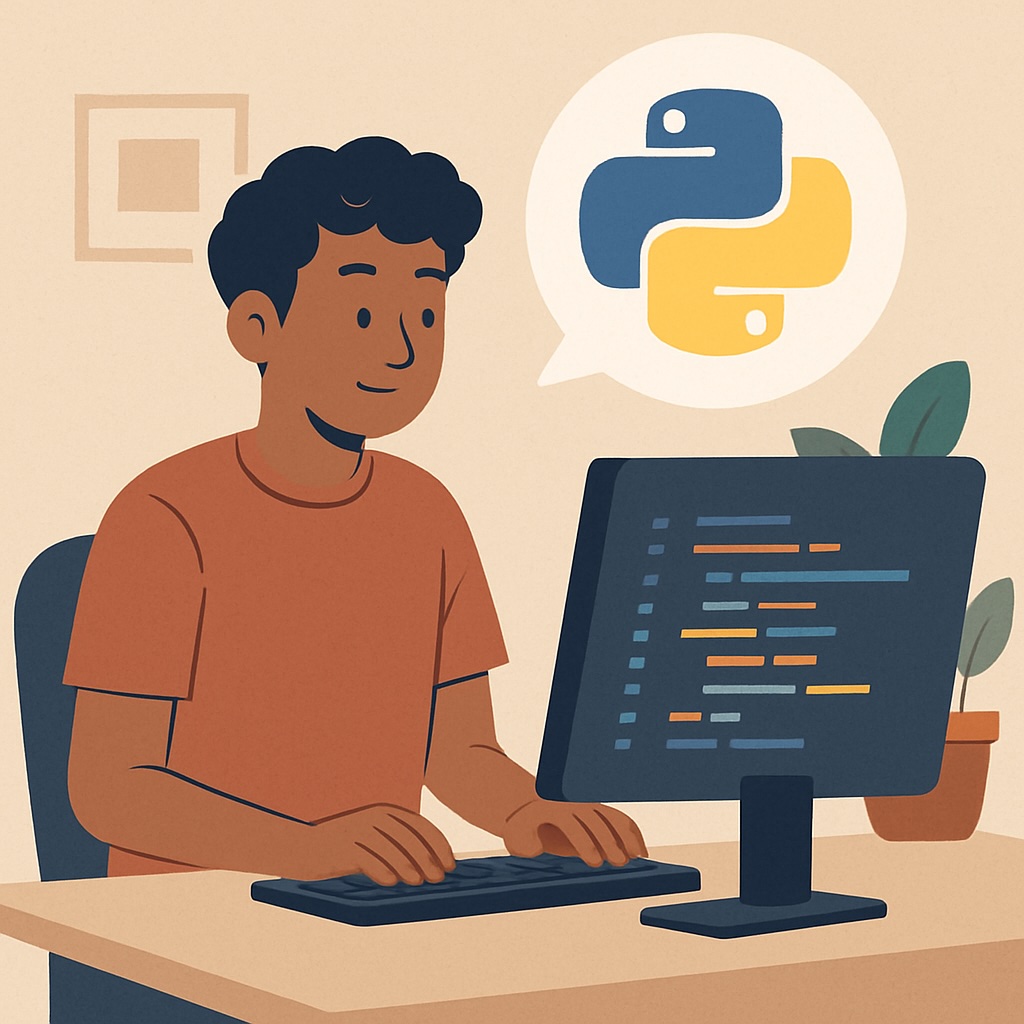History
Guido van Rossum
Python is an open-source programming language developed by Guido van Rossum in 1991. Van Rossum wanted to create a language that was both easy to read and write, resulting in Python’s signature clear and readable syntax. In its early years, Python was mainly used for automation, prototyping, and other programming tasks that benefited from the language’s simplicity and flexibility. Today, Python is used much more broadly, from web development and scripting to data analysis and artificial intelligence. By the way, the name 'Python' was inspired by the British comedy show Monty Python’s Flying Circus, of which Van Rossum was a big fan.

Rise of Python and NumPy
The rise of Python as a major tool for data analysis began in the early 2000s. During this period, several crucial libraries were developed that significantly expanded Python’s capabilities for scientific computing and data analysis. The first of these was NumPy, released in 2006, which added multi-dimensional arrays and a wide range of mathematical functions to Python. This made it possible to work efficiently with larger datasets and perform more complex calculations than was previously possible. NumPy still forms the foundation of many modern scientific and numerical computations in Python.
SciPy
In 2008, two years after the release of NumPy, SciPy was launched as an extension to NumPy, aimed at more specialized scientific and technical computing tasks. SciPy further enhanced Python’s scientific functionalities by adding modules for optimization, integration, interpolation, and statistics. Around the same time, Matplotlib was introduced, giving Python powerful data visualization capabilities. This enabled data scientists to visually analyze and present complex scientific data.
Pandas
The next major development in the evolution of Python for data analysis was the release of pandas in 2008. Designed by Wes McKinney, pandas provided data structures and functions specifically designed for data manipulation and analysis. With pandas, users could now easily load, clean, transform, manipulate, and analyze data, all within Python. Since then, pandas has proven to be an essential tool for most data analysis tasks, from financial analysis to bioinformatics.
Scikit-learn
The 2010s saw the rise of Python as a leading language in machine learning and data science. This was partly made possible by the introduction of Scikit-learn, a powerful machine learning library that offers standard algorithms for regression, classification, and clustering. The launch of TensorFlow and PyTorch, two frameworks for deep learning, enabled the development of even more complex models. These tools allowed data professionals to build and train advanced predictive models in Python, contributing to Python’s tremendous growth within the artificial intelligence (AI) and machine learning communities.
Python’s Popularity
Today, Python is one of the most popular languages for data analysis, machine learning, and artificial intelligence. It continues to evolve, with new libraries and tools constantly being developed, such as Dask for distributed computing and FastAPI for modern web development. Its simple, readable syntax combined with powerful data analysis and machine learning libraries makes Python an indispensable tool for data and analytics professionals worldwide. This has made Python popular not only among scientists but also within industry for developing data-driven products and services.
What makes Python popular for data analysis and analytics
Python's popularity is due to several key factors that make it one of the most widely used programming languages worldwide. It is not only easy to learn but also offers powerful capabilities for advanced programmers. Below, the main reasons for Python's popularity are discussed.
Simple and Accessible Syntax
One of Python's greatest advantages is its simple syntax. It is designed to be readable and resembles the English language more than many other programming languages. This makes it accessible to both beginners and experienced programmers. The ability to express complex ideas with less code makes Python attractive to those starting with programming as well as professionals looking to quickly develop workable solutions.
Expressiveness and Power
Python is a highly expressive language. This means that developers can implement complex algorithms and logic with relatively little code. This makes Python particularly well-suited for rapid prototyping and application development without unnecessary complexity. Python's strength lies in its simplicity: you can accomplish a lot in a relatively short time, significantly increasing developer productivity.
Extensive Standard Library
Python comes with an impressive standard library that offers a wide range of functionalities. From file management to network communication and from data structures to text processing, Python's standard library covers most basic needs for software development. This means that developers often don't need to install external libraries to perform common tasks, enhancing their work efficiency.
Active Open Source Community
Python is supported by a large and active open source community. This community continuously develops new libraries, frameworks, and tools that expand Python's capabilities. Whether it's web development, automation, data analysis, or artificial intelligence, there is a vast array of external libraries available that make it easier to realize projects quickly and efficiently. Popular libraries such as NumPy, Pandas, TensorFlow, and Scikit-learn are some of the tools that make Python so powerful for data analysis and machine learning.
Applications in Data Analysis and Machine Learning
Python has proven itself as the leading language for data analysis and machine learning. Thanks to its rich library ecosystem and the ease with which complex algorithms can be implemented, Python has become the preferred choice for data scientists and researchers. With tools like Pandas for data analysis, Matplotlib for visualization, and TensorFlow for deep learning, developers can quickly build and deploy robust models. This has secured Python a prominent place in the world of artificial intelligence and big data.
Future Growth and Innovation
Python continues to evolve, and its popularity keeps growing. The language is increasingly used in new and emerging technologies, including artificial intelligence, blockchain, and the Internet of Things (IoT). The combination of a strong community, ongoing innovations, and a user-friendly syntax makes Python an excellent choice for both beginners and experienced developers. The future of Python looks very promising, with an ever-broadening range of applications.

Core libraries for data analysis
Python's rich collection of libraries is one of the main reasons it is so powerful and versatile for data analysis. These libraries offer everything from simple data manipulation to advanced machine learning and deep learning. Below are some of the most popular and widely used libraries in Python for data analysis:
NumPy
NumPy is the foundation of many scientific libraries in Python. It provides efficient support for large, multi-dimensional arrays and matrices, and has an extensive collection of mathematical functions essential for numerical computations. From linear algebra to statistical calculations, NumPy is indispensable for almost any data analysis task. It is the standard library for working with numerical data in Python and offers excellent performance thanks to its optimized C implementation.
Pandas
Pandas is an essential library for manipulating and analyzing structured data. It offers powerful data structures like DataFrame and Series, which are optimized for working with tabular data and time series. Pandas makes data import and export easy, provides robust tools for handling missing values, grouping data, and performing aggregations. It has advanced functionality for manipulating time series, filtering data, creating pivot tables, and much more. It is the go-to library for preparing and cleaning data before further analysis.
Matplotlib
Matplotlib is the de facto standard library for data visualization in Python. With Matplotlib, users can create simple to complex charts, from line and bar charts to detailed heatmaps and 3D plotting. The library is flexible and gives users extensive control over visualizations, from adjusting colors and styles to adding annotations and labels. Matplotlib supports not only static visualizations but also interactive and animated charts, making it a valuable tool for both scientists and data analysts who want to effectively communicate their results.
SciPy
SciPy is a library built on top of NumPy and provides additional functionality for scientific and technical computing. SciPy offers a wide range of algorithms for numerical integration, optimization, interpolation, signal and image processing, linear algebra, and more. It is ideally suited for scientists and engineers who need to perform advanced computations, such as optimization tasks, integral calculations, or frequency analysis of signals. SciPy is often used together with NumPy to accelerate scientific computational tasks.
Scikit-learn
Scikit-learn is one of the most popular libraries for machine learning in Python. It offers a wide range of efficient tools for data modeling, including algorithms for classification, regression, clustering, and dimensionality reduction. Scikit-learn has a simple, consistent API that enables users to quickly build and evaluate different machine learning models. Whether you are a beginner or an advanced data scientist, Scikit-learn makes it easy to apply machine learning to your data and supports models such as linear regression, support vector machines (SVM), and decision trees.
TensorFlow and PyTorch
TensorFlow and PyTorch are two of the most popular deep learning libraries in Python. Both offer powerful tools for building and training neural networks, but they differ in their approach and application.
- TensorFlow: TensorFlow, developed by Google, offers a robust platform for building and deploying machine learning and deep learning models. It supports model training on both servers and mobile devices and provides tools for production environments. TensorFlow has extensive support for GPU acceleration and offers the ability to scale models to large datasets and complex tasks. TensorFlow 2.x uses a dynamic graph and is simpler to use than earlier versions, making it more accessible to researchers and developers.
- PyTorch: PyTorch, developed by Facebook, is often praised for its user-friendly interface and dynamic graphs, which increase flexibility for research purposes. This makes PyTorch particularly attractive to academics and researchers who want to quickly develop and experiment with new models. PyTorch offers excellent GPU acceleration support and makes it easy to build and train complex neural networks. In recent years, PyTorch has proven itself as a leading tool for both academic research and production environments.
Both libraries have their strengths, and the choice between TensorFlow and PyTorch often depends on the specific requirements of a project and the user's preference.

How to Use Python for Data Analysis
Introduction to Python for Data Analysis
Python is one of the most popular programming languages for data analysis due to its extensive libraries and the versatility it offers. Below are the steps you can follow to get started with data analysis in Python.
1. Installing Python and Required Libraries
The first step in using Python for data analysis is installing the language itself, along with the necessary libraries. This can easily be done using pip, Python’s built-in package manager, or by using an Anaconda distribution. Anaconda is a popular choice in the data science community because it includes a comprehensive suite of tools and libraries, such as pandas, numpy, and matplotlib, right out of the box. This makes it easy to quickly get started with data analysis without having to install separate packages individually.
2. Python Environments and IDEs
Once Python is installed, you can write and execute code in various environments. A simple option is to use a text editor, but for a more comprehensive experience, you can use a dedicated Python IDE (Integrated Development Environment) such as PyCharm or Visual Studio Code. These environments offer helpful features like error checking, autocomplete, and debugging.
Another popular option is Jupyter Notebook, an interactive workspace where you can write code, run it, add visualizations, and even document your results in a single, readable document. Jupyter Notebooks are particularly useful in data science because they allow seamless integration of code, text, and graphics, making them ideal for prototyping and data visualization.
3. Reading Data
The first real step in the data analysis process is reading in the data. Python offers excellent support for reading data from various sources, such as CSV files, Excel files, SQL databases, JSON files, and even REST APIs. The pandas library is the most popular tool for this purpose, thanks to its intuitive functions for reading, manipulating, and analyzing data. Pandas also supports time series and larger datasets that fit in memory, making it a powerful tool for many common data analysis tasks.
4. Data Analysis and Manipulation with Pandas
After reading the data, you can further analyze and manipulate it using pandas. It offers countless functions for filtering, sorting, grouping, summarizing, and transforming data. For example, you can easily perform aggregations, impute missing values, and merge data from different sources.
For visualizing data, you can use libraries like matplotlib and seaborn, which provide powerful tools for creating charts and graphs. Additionally, newer libraries such as Plotly and Altair support interactive visualizations, allowing users to interact with and explore the data through dynamic charts.
5. Advanced Data Analysis: Statistics and Machine Learning
For more advanced analyses, such as statistical tests, machine learning, or even deep learning, there are additional libraries available. SciPy and statsmodels offer a comprehensive collection of statistical tools, while scikit-learn provides algorithms for both supervised and unsupervised learning. These libraries cover everything from regression and classification to clustering and dimensionality reduction.
For deep learning applications, powerful frameworks like TensorFlow and PyTorch are available, enabling the development of neural networks and other complex machine learning models. These libraries offer advanced features such as GPU acceleration and automatic hyperparameter tuning, making them particularly well-suited for training models on large datasets.
6. Conclusion
Using Python for data analysis is a powerful tool for both beginner and advanced data scientists. The broad support from open-source libraries enables a wide range of data analysis tasks, from simple data cleaning and visualization to advanced machine learning and deep learning. Python's flexibility and the vast community of users make it an excellent choice for anyone working with data.

Examples of Python Application in Data and Analytics
Python has a wide range of applications in data analysis and analytics, thanks to its flexibility and extensive set of libraries. Here are some concrete examples:
Data Cleaning and Preparation
Data analysis often starts with cleaning and preparing raw data. With Python and libraries like pandas, professionals can load data from various sources, detect inconsistencies, handle missing values, remove duplicates, and transform data into a format suitable for analysis. Additionally, new techniques such as data imputation and outlier detection can be easily implemented.
Exploratory Data Analysis (EDA)
Python makes it easy to perform exploratory data analysis, which helps in understanding the underlying structures and patterns in the data. With libraries like pandas, seaborn, and matplotlib, data professionals can generate summary statistics, analyze correlations, and create informative visualizations. New tools like Plotly and Altair offer interactive visualizations that further deepen insights and allow users to present analyses more dynamically.
Predictive Modeling and Machine Learning
Python is a leading language in machine learning and AI. With libraries such as scikit-learn, TensorFlow, Keras, and PyTorch, professionals can build and train predictive models, ranging from simple linear regression to complex neural networks. Moreover, advanced techniques like transfer learning and reinforcement learning are now widely available in Python, facilitating the application of AI models.
Natural Language Processing (NLP)
Python offers strong support for NLP tasks such as sentiment analysis, topic modeling, and text mining. Libraries like NLTK, SpaCy, transformers, and gensim make it easy to work with text data. The rise of transformer-based models like BERT and GPT has significantly improved the performance of NLP tasks, making it easier to solve complex issues such as text generation and translation.
Web Scraping and Data Collection
Python is also popular for web scraping and data collection. Libraries like BeautifulSoup, Scrapy, and Selenium make it possible to collect data from websites for further analysis. Integration with APIs is also becoming more common, making it easier to collect real-time data from various platforms.
Automation of Data Analysis Tasks
Python is a powerful tool for automating repetitive data analysis tasks. Using scripts, professionals can automate tasks such as data collection, data cleaning, model training, and validation, helping to increase efficiency and reduce errors. By leveraging workflows and tools like Apache Airflow, more complex automations can be set up to manage multiple steps in the process.
Big Data Analysis
With libraries such as Dask, PySpark, and Vaex, Python can handle datasets too large to fit into the memory of a single machine, which is essential in the era of big data. These tools enable distributed processing, making Python suitable for analyzing massive amounts of data, from streaming data to historical datasets.

Python and Big Data
Big Data
Python is exceptionally well-suited for working with big data. Libraries like Dask, PySpark, and Vaex allow you to write Python code that can be executed in a parallel or distributed manner. This is essential for processing massive datasets that cannot fit on a single machine. By using these tools, you can significantly improve the performance of your applications.
Dask
Dask is a library that enables large-scale computations, even on a single machine, by distributing the workload across multiple cores. It offers a compatible API with pandas and NumPy, making the transition to Dask easy for existing projects. Dask can run both on a single machine and on a cluster of machines, making it highly suitable for both small and large data environments.
PySpark
PySpark is the Python interface for Apache Spark, a powerful framework for big data processing that enables distributed computing across a cluster of machines. It allows users to manipulate and analyze data that is far too large to fit on one machine. PySpark offers a range of advanced analytics capabilities and is perfect for performing complex computations on large datasets, both in batch processing and real-time streaming.
Vaex
Vaex is another emerging library specifically designed for efficiently working with large datasets that do not fit into memory. It uses out-of-core processing, allowing you to manipulate and analyze datasets much larger than the available memory without compromising performance. Vaex is ideal for quickly exploring data and performing statistical analyses on large volumes of data.

Python skills and job opportunities
Mastering Python is a valuable skill for professionals who want to stand out in the job market. Python is widely used across various industries, including technology, finance, healthcare, and marketing. Jobs that require Python skills range from data analyst and business intelligence specialist to data engineer and software developer. By improving your Python skills, you not only increase your chances of securing a job but also of obtaining a higher salary and better career advancement opportunities. Employers are often looking for professionals who not only understand the fundamentals of Python but can also write complex algorithms and apply advanced data analysis methods.

Looking for data and analytics specialists?
For a small fee, you can easily post your vacancies on our platform and reach our large, relevant network of data and analytics specialists. Applicants respond directly to you, without any third-party involvement.
On DataJobs.nl, we connect supply and demand in the data and analytics job market directly—without intermediaries. You won't find vacancies from recruitment agencies here. Visitors can view all vacancies for free and without an account, and apply directly.
Check out the options for posting vacancies here. Questions? Get in contact with us!
Op zoek naar een uitdaging in data & analytics?
Bekijk hier alle actuele kansen! See vacancies- History
- What makes Python popular for data analysis and analytics
- Core libraries for data analysis
- How to Use Python for Data Analysis
- Examples of Python Application in Data and Analytics
- Python and Big Data
- Python skills and job opportunities
- Jobs for professionals with Python skills
- Looking for data and analytics specialists?



